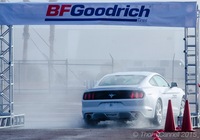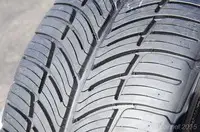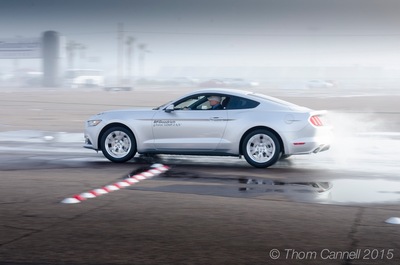BFG g-Force Comp-2 A/S - Hot New Tire for American Muscle and
Luxury Imports
By Thom Cannell
Senior Editor
Michigan Bureau
The Auto Channel
Every tire has a story, a purpose, a market, a use. BFG’s
g-Force Comp-2 A/S is an all season ultra high performance tire for
American Muscle and EuroAsian luxury performance cars. The new g-Force
Comp-2 A/S is the successor to BFG’s g-Force Super Sport and
compliments the summer-only g-Force Sport Comp-2. We find those similar
names a bit confusing, so think “sport equals summer only, A/S means,
well, all season”. Let’s get another thing out of the way up
front. Tire manufacturers no longer tout all season tires as meant for deep
snow and ice, if they ever did. BFG says the g-Force Comp-2 A/S is good for
light fall and early spring snows, not the blizzards that are just melting
in Boston Harbor. If you live in snow country you must have winter tires.
We came to sunny Phoenix ready to test the g-Force Comp-2 A/S and
were met with chill and rain, which is good for testing an all season tire,
it challenges the promises. Our first questions about the tires were
simple, what makes up a tire, starting from the bead-seat surface to the
tread, and how is this tire different from others. Really, why would YOU
want to shell out $300 and up for a set, other than the 45,000-mile
warranty.
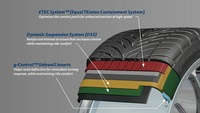
|
Assuming you know just a bit about tires, here’s a primer on
basics from Dirk McDonald, Product Category Manager - BFG Ultra High
Performance and tire development engineer Roark Baird. The most obvious
part of the tire is its tread. Tread design delivers biting edges for grip
in all seasons, particularly in snow. The voids evacuate water to prevent
hydroplaning. How the tread blocks are formed, their direction, size and
orientation (sculpture), deliver stability. What the tread rubber is made
of is what determines traction and grip in summer and winter. For cold
weather the compound has to remain flexible to grip the ice and snow, in
summer it has to resist heat buildup. This is a delicate balance and
compounds have vastly improved in the last 5-7 years. Now you can have a
tire that remains flexible in the winter while resisting heat buildup on
scorching summer days while challenging your favorite winding road.
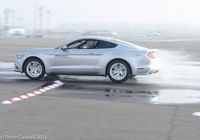
|
The next piece of tire is at the opposite side, the connection
between wheel and tire, the bead seat. For this tire it’s called the
g-wedge which locks to the rim. In a J shape, radial plys wrap around the
g-wedge (g-control sidewall inserts in our illustration) and over to the
opposite side to again wrap the wedge. Put together, these form the DSS,
dynamic suspension system that we’d call the main structure. They are
what gives any tire its basic shape and actually delivers the sidewall
stiffness (or lack of stiffness) that determines how crisply a tire turns
in and how precisely your car handles. The DSS (by any name) also
determines how harshly road forces will come back to your chassis. Super
strong sidewalls might turn like a go-kart’s wheels, but you’d
be beaten to jelly on any thing but glass-smooth pavement.
Next are the steel belts. These steel cords are embedded in rubber
sheets, deliberately separated and specifically angled. That’s tire
engineering and it creates stability beneath the tread. Following the belts
is ETEC, what BFG calls the containment system, which is a reinforcement
layer to optimally stabilize the tire contact patch. This creates and
maintains the high speed performance characteristics.
Now we’re back to the tread, where the size and spacing of
individual blocks makes a difference, to your ears. Blocks must be sized
and spaced to minimize noise production, which is impossible to achieve.
Complex computer algorithms size and place the blocks to make an acceptable
white noise. Other 3D design apps help determine performance
characteristics. This BFG calls “g-Force Tread”.
For the g-Force Comp-2 A/S, shoulders are squared off to put more
rubber–the contact patch–on the ground. Wraparound outer tread
makes for more rubber when cornering at the limit and it looks way cool.
Individual tread blocks are large and rigid for less “squirm”,
and the rubber compound itself uses lots of silica to improve cold weather
traction.
In Phoenix we tested BFG’s claims that the new tire has great
“A-B-Cs”. “Accelerates faster, brakes shorter, and
exhibits control in all seasons,” according to marketing manager
Marcus Wilson. How did they prove their claims? At Wild Horse Pass Raceway
(formerly Firebird) with water, competitors tires, and cars.

|
There were specific tests, wet handling using Mustangs, wet and dry
braking in Audi A5s, and dry autocross in Scion FR-S’. Each test was
begun in a g-Force Comp-2 A/S-equipped car, followed by competitor tires.
Our group began in the fog and mist, driving Mustangs against General G-Max
AS-03, and Yokohama AVID Envigor. Our notes read “ Much better grip
than the others. Compared to the General tire, much better grip and
accuracy, noticeably better than the Yokohama. Yokohama has marginally less
input accuracy, but near-equal wet braking, full ABS, stopping. The General
was far less crisp, had less accuracy in steering input at any speed (0-45
mph), and far less stopping power or feel under ABS wet braking”.
Our next bit of fun involved Scion FR-S’ and an autocross. By
then the sun had arrived and warmed the track. For this comparison the
tires were the same, though obviously in different sizes. Our short course
emulate left-right evasion, a fixed radius corner, and an S with a sharper
final curve. We approached this professionally, darn it, so not maximum
speed but maximum repeatability.
Again the BFG tire delivered on its promises. Notes say the General
tire was far less accurate in steering response, had more oversteer, and
less grip. It felt like the tires were under-inflated. The Yoko tire was
better, though still with understeer and less grip or accuracy. Our notes
say that, overall, the Comp-2 felt more grippy, and accurate than either
competitor, and offered more direct connection between steering
wheel–tire contact patch–road surface.
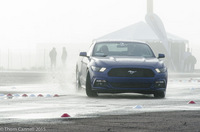
|
Finally we sped down a straight track in Audi A5s to a velocity of
50 mph and nailed the brakes. A full two-footed panic stop! There, too,
against the Hankook Ventus S1 Noble2, the BFG tire prevailed, stopping
shorter in almost every case (there were occasional brake application
failures), wet or dry. Averaging about 60 events, the results showed
several feet shorter stopping distance wet, or dry. The company attributes
this to the squared tread design that stores and expels water, and the
amount of silica in the tread. We thought the Hankook felt smoother and
softer, the BFG more granular, more mechanical, delivering more connection
with the road. It also had more control.
Beginning in April you’ll see the initial rollout of the
g-Force Comp-2 A/S, the first 39 of an eventual 51 sizes that will cover
over 97% of its market.
The first sizes in April will be 33 and overall we will release 59 total sizes.
BFG is willing to put its products head-to-head with direct in-class
competitors, which we love. It gives us an opportunity to deliver honest
evaluations from a subjective point of view. After all, that’s where
you’ll be sitting.
